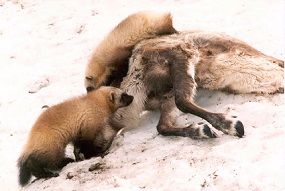 The wolverine has been described as a facultative scavenger (van Dijk et al. 2008, Mattisson et al. 2011) due to seasonal preferences for carrion versus live prey. Wolverines would probably not persist in the absence of ungulate populations, although evidence suggests at least a seasonal reliance on local rodent abundance (Magoun 1985, Gardner 1985, Banci 1987, Landa 1997, Persson 2005, Lofroth et al. 2007, van Dijk et al. 2008). Seasonal and regional variation in diet may also be related to prey availability (Lofroth et al. 2007) and may be influenced by the presence of other large carnivores. van Dijk et al. (2008) found wolverine use of moose carcasses to be elevated in forest habitats that included wolves (Canis lupus) over habitats where wolves were absent indicating a reliance on wolf prey remains. The wolverine is capable of taking large ungulates as live prey (Magoun 1985, Landa 1997), and while ungulate presence in the wolverines diet most likely results from scavenging (Hornocker and Hash 1981, Magoun 1985, Gardner 1985, Banci 1987, Copeland 1996, Landa 1997, Lofroth et al. 2007, van Dijk et al. 2008, Mattisson et al. 2011), ungulates were reported as the predominate prey item across seasons in British Columbia (Lofroth 2007) and Idaho (Copeland 1996). Ground squirrels were most prevalent in late winter and spring diets in Alaska (Magoun 1985, Gardner 1985), while snowshoe hare (Lepus americanus) contributed the highest proportion of any single species to the wolverine’s diet in Yukon (Banci 1987). Hoary marmot (Marmota caligata) was a prevalent prey item at reproductive dens of Canadian wolverines (Lofroth et al. 2007). Rodent abundance was positively correlated with reproductive success in Norway (Landa et al. 1997) and Sweden (Persson 2005). Vegetation has been reported in the diet of wolverines with speculation that plant ingestion occurs incidental to animal prey consumption (Banci 1987). However, Wood et al. (2009) reported plant terpenes as a predominant volatile component of free-ranging wolverine urine indicating that vegetation may be consumed in lieu of animal prey.
The wolverine has been described as a facultative scavenger (van Dijk et al. 2008, Mattisson et al. 2011) due to seasonal preferences for carrion versus live prey. Wolverines would probably not persist in the absence of ungulate populations, although evidence suggests at least a seasonal reliance on local rodent abundance (Magoun 1985, Gardner 1985, Banci 1987, Landa 1997, Persson 2005, Lofroth et al. 2007, van Dijk et al. 2008). Seasonal and regional variation in diet may also be related to prey availability (Lofroth et al. 2007) and may be influenced by the presence of other large carnivores. van Dijk et al. (2008) found wolverine use of moose carcasses to be elevated in forest habitats that included wolves (Canis lupus) over habitats where wolves were absent indicating a reliance on wolf prey remains. The wolverine is capable of taking large ungulates as live prey (Magoun 1985, Landa 1997), and while ungulate presence in the wolverines diet most likely results from scavenging (Hornocker and Hash 1981, Magoun 1985, Gardner 1985, Banci 1987, Copeland 1996, Landa 1997, Lofroth et al. 2007, van Dijk et al. 2008, Mattisson et al. 2011), ungulates were reported as the predominate prey item across seasons in British Columbia (Lofroth 2007) and Idaho (Copeland 1996). Ground squirrels were most prevalent in late winter and spring diets in Alaska (Magoun 1985, Gardner 1985), while snowshoe hare (Lepus americanus) contributed the highest proportion of any single species to the wolverine’s diet in Yukon (Banci 1987). Hoary marmot (Marmota caligata) was a prevalent prey item at reproductive dens of Canadian wolverines (Lofroth et al. 2007). Rodent abundance was positively correlated with reproductive success in Norway (Landa et al. 1997) and Sweden (Persson 2005). Vegetation has been reported in the diet of wolverines with speculation that plant ingestion occurs incidental to animal prey consumption (Banci 1987). However, Wood et al. (2009) reported plant terpenes as a predominant volatile component of free-ranging wolverine urine indicating that vegetation may be consumed in lieu of animal prey.
<< Back to Species Account Overview
Literature Cited
Banci, V. A. 1987. Ecology and behavior of wolverine in Yukon. Thesis, University of British Columbia, Vancouver, British Columbia, Canada.
Copeland, J. P. 1996. Biology of the wolverine in central Idaho. Thesis, University of Idaho, Moscow, USA.
Gardner, C. L. 1985. The ecology of wolverines in southcentral Alaska. Thesis, University of Alaska, Fairbanks, Alaska, USA.
Hornocker, M. G., and H. S. Hash. 1981. Ecology of the wolverine in northwestern Montana. Canadian Journal of Zoology 59:1286 1301.
Landa, A. O. Strand, J. E. Swenson, and T. Skogland. 1997. Wolverines and their prey in southern Norway. Canadian Journal of Zoology 75:1292-1299.
Lofroth, E. C., J A. Krebs, W. L. Harrower, and D. Lewis. 2007. Food habits of wolverine Gulo gulo in montane ecosystems of British Columbia, Canada. Wildlife Biology 2: 31-37.
Magoun, A. J. 1985. Population characteristics, ecology and management of wolverines in northwestern Alaska. Dissertation, University of Alaska, Fairbanks, Alaska, USA.
Mattisson, J., J. Persson, H. Andrén, and P. Segerström. 2011. Temporal and spatial interactions between an obligate predator, the Eurasian lynx (Lynx lynx), and a facultative scavenger, the wolverine (Gulo gulo). Canadian Journal of Zoology 89:79-89.
Persson, J. 2005. Female wolverine (Gulo gulo) reproduction: reproductive costs and winter food availability. Canadian Journal of Zoology 83:1453–1459.
Van Dijk, J., L. Gustavsen, A. Mysterud, R. May, Ø. Flagstad, H. Brøseth, R. Andersen, R. Andersen, H. Steen, and A. Landa. 2008. Diet shift of a facultative scavenger, the wolverine, following recolonization of wolves. Journal of Animal Ecology 77:1183-1190.
Wood. W. F., J. P. Copeland, R. E. Yates, I. K. Horsey, and L. R. McGreevy. 2009. Potential semiochemicals in urine from free ranging wolverines (Gulo gulo Pallas, 1780). Biochemical Systematics and Ecology 37:574-578.
 Follow
Follow